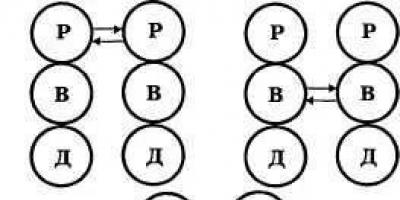Scrivo con una penna. - I write with a pen;
3) the preposition con introduces circumstances of the manner of action that answer the question how?
Ascolta con attenzione. - He listens carefully.
Leggono questo articolo con interesse. - They read this article with interest.
Mauro mangia con appetito. - Mauro eats with gusto.
The preposition su is used to indicate:
1) circumstances of a place indicating the location of an object on the surface anything:
Il piatto è su questa tavola. - The plate is on this table.
Su questa parete ci sono molti quadri. - There are many paintings hanging on this wall;
2) Russian pretext in in phrases in a newspaper, in a magazine or in
Internet:
Legge un articolo su l giornale. - He is reading an article in the newspaper.
Cerco informazione su l Internet. - I'm looking for information on the Internet.
The preposition per is used to denote: 1) the Russian preposition for:
Porto regali per tutti. - I'm bringing gifts for everyone;
2) circumstances of the goal, answering the question why? Vado in Italy per studio. - I'm going to Italy to study.
Dobbiamo partire adesso per arrivare in tempo. - We must leave now to arrive on time;
3) circumstances of the place answering the questions for what time? for how long?
Va in vacanza per due settimane. - He is going on vacation for two weeks. Siamo rimasti a Venezia per cinque giorni. - We stayed in Venice for five days.
4) the preposition per also corresponds to the Russian preposition by , which introduces the circumstance of place:
Mi piace girare per la città. - I like to walk around the city;
5) The preposition per introduces an object that answers the questions for whom? for what?
Sono contento per mio figlio. - I'm happy for my son.
Ringrazio il mio collega per l’aiuto. - I thank my colleague for his help.
The preposition tra (= fra) corresponds to Russian prepositions
1) between
Vengo tra le cinque e le sei. - I'll come between five and six o'clock.
Tra la casa e la palizzata c'è un giardino. - Between the house and the fence there is a garden.
2) through
Partiamo fra un'ora. - We're leaving in an hour. 3) among
Tra i miei amici ci sono molti stranieri. - Among my friends there are many foreigners.
5.3. CONNECTED PREPOSITIONS
It is important to remember that the definite article in combination with the prepositions di, a, da, in, su forms the following articulated prepositions:
di + il = del |
a + il = al |
da + il = dal |
||
di + lo = dello |
a + lo = allo |
da + lo = dallo |
||
units number |
di + l’ = dell’ |
a + l’ = all’ |
da + l’ = dall’ |
|
masculine |
di + i = dei |
a + i = ai |
da + i = dai |
|
pl. number |
di + gli = degli |
a + gli = agli |
da + gli = dagli |
|
di + la = della |
a + la = alla |
da + la = dalla |
||
di + l’ = dell’ |
a + l’ = all’ |
da + l’ = dall’ |
||
units number |
||||
feminine |
di + le = delle |
a + le = alle |
da + le = further |
|
pl. number |
||||
masculine |
in + il = nel |
su + il = sul |
|
units number |
in + lo = nello |
su + lo = sullo |
|
in + l’ = nell’ |
su + l’ = sull’ |
||
masculine |
in + i = nei |
su + i = sui |
|
pl. number |
|||
in + gli = negli |
su + gli = sugli |
||
feminine |
in + la = nella |
su + la = sulla |
|
units number |
in + l’ = nell’ |
su + l’ = sull’ |
|
feminine |
in + le = nell |
su + le = sulle |
|
pl. number |
|||
Remember the names of the seasons:
Le stagioni - the seasons l’inverno (m) - winter
la primavera (f) - spring l’estate (f) - summer l’autunno (m) - autumn
The preposition IN is used with all seasons: in inverno (=d’inverno) - in winter
in primavera (=di primavera) - in spring in estate (d’estate) - in summer
in autunno (d’autunno) - in the fall
When specifying the year preposition is used IN + def. article : nell'inverno 1994 - winter 1994
nella primavera 2001 - spring 2001

Month names
I mesi - months gennaio - January febbraio - February marzo - March aprile - April maggio - May giugno - June luglio - July agosto - August settembre - September ottobre - October novembre - November dicembre - December
The preposition IN is used with all month names: in gennaio - in January
in febbraio - in February, etc.
When indicating the year, the preposition IN + def is used.
article:
Date designation
To indicate the numbers of the month are used
cardinal numbers with the definite article: il due maggio - second of May
il venticinque giugno - twenty-fifth of June
But to indicate the first day of the month, the ordinal number primo is used: il primo luglio - the first of July
The year is indicated using the articulated preposition NEL. In this case, a cardinal number is used, and the word “year” is omitted:
nel 2011 (duemilaundici) - in 2011
But for the expression quest'anno (this year) no preposition is required: Quest'anno vado al mare. - This year I’m going to the sea.
5.4. FEATURES OF USING PREPOSITIONS
WITH WITH VERBS ANDARE, ESSERE, VENIRE
1) After the verbs andare (to go, go), venire (to come, to arrive), essere (to be, to be), the preposition IN is used in the following cases:
- before the names of countries and regions: in Italy, in Tuscany
Sono in Italy, in Sicilia. - I am in Italy, Sicily. Andiamo in Germania. - We are going to Germany.
Quando vieni in America. - When will you come to America?
Before the words: in vacanza, in albergo, in città, in ufficio, in centro, in banca, in farmacia, in biblioteca, in discoteca, in montagna:
Pietro è in ufficio. - Pietro is in the office. Carlo va in vacanza. - Carlo is going on vacation.
Vieni in discoteca stasera? -Are you going to the disco this evening?
- to express movement on any transport: in treno, in aereo, in autobus, in macchina, in moto, in motorino, in bicicletta:
Sei in macchina? - Are you by car? Vengo in motorcycle. - I'll come on a motorcycle.
Andiamo in bus. - We are going by bus.
2) After the verbs andare (to go, go), venire (to come, to arrive), essere (to be, to be), the preposition A is used in the following cases:
- before the names of cities: a San Pietroburgo, a Roma
Vanno a Mosca. - They are going to Moscow.
Siamo a Londra. - We're in London.
- to express the location or direction of movement of an object before the words: a casa, a teatro, a scuola, a letto, a pranzo, a cena:
Sei a casa? - Are you home?
Vado a letto. - I am going to sleep. (lit. I'm going to bed)
Vieni a teatro stasera? -Are you going to the theater tonight?
- in stable terms: a piedi - on foot
Veniamo a piedi. - We'll come on foot.
Preferisco andare a piedi. - I prefer to walk.
3) The verbs andare and venire attach the infinitive of another verb using the preposition A:
Oggi andiamo a ballare. - Today we are going to dance. Vengo a studio in France. - I'm going to study in France.
4) After the verbs andare (to go, go), venire (to come, to arrive), essere (to be, to be) the preposition A + article
used to express the location or direction of movement of an object before the words: al cinema, al mare, al bar, al ristorante, al lavoro, all’università:
Vieni al cinema stasera? -Are you going to the cinema tonight? Vanno al mare. - They are going to the sea.
Sono al lavoro. - I'm at work.
5) After the verbs andare (to go, go), venire (to come, to arrive), essere (to be, to be) the preposition DA in combination with
An animate noun is used to denote movement towards someone or being a guest at someone:
I ragazzi vanno da Anna. - The guys are going to Anna. Sono da Angelo. - I'm visiting Angelo.
6) If after the verb venire follows the preposition DA combined with the name of the locality, That this proposal translated into Russian as “to be from”:
Vengo da Napoli. - I (come) from Naples. Veniamo da Mosca. - We (come) from Moscow.
5.5. FEATURES OF USING PREPOSITIONS
WITH VERB PARTIRE (LEAVE)
1) The phrase “to leave in the direction of somewhere" is translated into Italian using the preposition PER. Before names of cities The definite article is not used:
Ugo parte per Torino. - Hugo is leaving for Turin. Parto per le vacanze. - I'm going on vacation. Partiamo per la Spagna. - We are leaving for Spain.
2) The phrase "to leave" from somewhere" is translated into Italian using the preposition DA:
Parto da ll'Italia lunedì. - I'm leaving Italy on Monday.
Il treno parte da Bologna alle 11. - The train departs from Bologna to

3) The phrase “to leave by any means of transport” is translated into Italian using the preposition IN:
Noi partiamo in treno e lui parte in aereo.
Exercise 1. Translate into Italian:
in November, January, winter, September 15, summer, June, 1978, April, 2007, autumn, March 1, this year, February 2011, May 8, July 16, December 19, spring , in August 2005, May 24, 2000, January 1.
Exercise 2. Place prepositions and articles where they are
necessary. |
||||||||||||
1.Quando tornate...... |
Russia? 2. Paola abita |
Firenze. 3...... |
||||||||||
4. Claudia parte..... |
Roma mercoledì. 5. Il treno arriva |
|||||||||||
suo carattere.7. Ho conosciuto |
||||||||||||
Boston. 8. Passiamo la |
Paola. 9. La posta non |
|||||||||||
Autobus. 10. Quanti giorni pensate di restare........ |
||||||||||||
11. Andiamo…….aeroporto. 12. Quanti giorni pensate di restare |
||||||||||||
città? 13. Finiamo..... |
studiare e andiamo..... |
mangiare una pizza. 14.Devo |
||||||||||
finire questo lavoro prima...... |
otto. 15. La mia casa è vicino...... |
|||||||||||
lontano......... |
Autobus. |
|||||||||||
Macchina di Enrico. 18. Parti........ |
Francia? Sì, ma non adesso. Parto |
|||||||||||
Un mese, ..... April. 19. Il prossimo treno per Venezia parte...... |
||||||||||||
mezzo. 20.Va..... |
comprare il giornale. 21. Dov’è la casa .......... |
|||||||||||
Appena esco...... |
||||||||||||
casa. 24. Not so quale .......... |
questi due vestiti mettere. 25. Quando |
|||||||||||
partite….Parigi? 26. Marco, dove abiti? - …….Perugia. 27. Vado…..cena…..Paola stasera. 28. Claudio parte………vacanze domani. 29. Voglio regalare questi fiori…….Paola. 30. Torna…..settembre.
Prepositions are used to form many question words.
a chi? - to whom? con chi? - with whom?
con che cosa? - how?
da quando? - since when? how long ago? fino a quando? - until when? fino a che ora? - Till what time?
per quanto tempo? - for how long? con che mezzo? - by what transport?
5.6. USAGE OF THE WORDS MOLTO, POCO, TROPPO
The words molto, poco, troppo can take the form of adjectives and adverbs.
When molto is an adjective, it agrees with noun in gender and number and non-Russian language is translated by the word “many”. A noun accompanied by the adjective molto is always used without an article:
Abbiamo molto tempo. - We have a lot of time.
In piazza ci sono molti turisti. - There are a lot of tourists in the square. Ho molte amiche. - I have many friends.
When molto acts as an adverb, it is translated into Russian with the word “very”. This adverb is used with adjectives and verbs and does not change in gender or number. If the adverb molto modifies an adjective, it is placed before it:
Mario and molto alto.
Anna e Luisa sono molto alte.
If the word molto defines a verb, then it, like all adverbs in the Italian language, is placed after the verb:
Questo libro mi piace molto. - I really like this book.
Exercise 3. Make up phrases with the following nouns, adjectives, verbs and the word molto. Make up sentences with these phrases:
cara, persone, feste, regali, bere, sorpresa, contento, acqua, viaggiare, vecchi, fredda, carta, pagare, stupido, fiori, largo, bambini, università, banane, parlare, gatte.
- Indefinite adjective poco precedes noun without an article and agrees with it in gender and number. It is translated into Russian by the adverb “little”:
Ho poco tempo libero. - I have little free time. Abbiamo pochi soldi. - We don't have much money.
Marta ha poche amiche. - Martha has few friends.
- As an adverb poco is translated into Russian as “not very” or “little” and can define both a verb and
adjective:
Tina studio poco. - Tina doesn’t study much.
Siamo poco contenti. - We are not very happy.
Exercise 4. Make up phrases with the following nouns, adjectives, verbs with the word poco. Make up sentences with these phrases:
studenti, capire, camere, anni, interessante, assomigliare, capire, leggere, negozi, importante, difficile, soldi, feste, giorni, vedere.
- Adjective troppo used before nouns and agrees with it in gender and number:
Fai troppi sbagli. - You make too many mistakes.
Questo caffé non è buono, c’è troppa acqua . - This coffee is tasteless, it contains
too much water.
The adverb troppo is translated into Russian as “too, too much, too much.” When defining a verb, it is placed after it, when defining an adjective, it is placed before it:
Parli troppo. - You talk too much.
Questo esercizio and troppo difficile. - This exercise is too difficult.
Exercise 5. Make up phrases with the following nouns, adjectives, verbs with the word troppo. Make up sentences with these phrases:
informazione, piccola, impegni, lungo, problemi, caro, esami, facile, macchine, acqua, zucchero, buona, tempo.
The adjective tutto (all) agrees in gender and number with the noun it refers to. Tutto is always placed before a noun, and between them it is necessary to use
definite article:
Cerco gli occhiali per tutto il giorno. - I've been looking for glasses all day.
Dalla finestra vediamo tutta la piazza. - From the window we see the entire square. Tutti i bambini sono contenti. - All the children are happy.
Tutte le città d’Italia sono belle. - All cities in Italy are beautiful.
Exercise 6. Add the adjective tutto to the following nouns. Make up sentences with these phrases:
anni, città, lezioni, festa, giorno, turisti, regali, ragazze, spettacoli, casa, inverno, artisti, estate, invezioni, persone, primavera, film, scrittori, vacanza.
5.7. INDEFINITE PRONOUNS MOLTO, POCO, TUTTO, NIENTE, NESSUNO
There are indefinite pronouns molto, poco, tutto , which can act independently in a sentence as the subject. Molti vanno in vacanza in agosto. – Many people go on vacation in August. Pochi restano in città i fine settimana. – Few people stay in the city on weekends.
A Roma mi piace tutto. – I like everything in Rome. Tutti vogliono fare carriera. - Everyone wants to make a career. Non mi ascolta nessuno. - Nobody listens to me. Niente è impossibile. - Nothing is impossible.
Exercise 7. Translate into Italian.
1. Everyone does it. 2. Many people listen to this radio. 3. Why is no one working? 4. Nobody sings. 5. Everyone plays football. 6. Few people like to study. 7. Everyone wants to earn good money. 8. I don't see anything. 9. Everyone is busy. 10. Everything seems simple.
L’USO DELLE PREPOSIZIONI – USE OF PREPOSITIONS
The preposition "DI" introduces:
1. addition of a noun indicating belonging:
Di chi è questa penna? [dick e cuesta pennna] → Whose pen is this?
È di Pietro. [e di Pietro] → This is Peter's pen.
Il libro di italiano. [il lIbro di Italiano] → Book on the Italian language.
2. indirect object and circumstance:
Parliamo di te. [parliamo di te] → We are talking about you.
Esco di casa. [esko di kaza] → I leave the house.
Muoio di fame. [muoyo di fAme] → I'm dying of hunger.
The preposition “A” (before the vowel - ad) introduces:
1. indirect object answering the questions a chi? (to whom?), a che cosa? (to what?):
Porta le chiavi a Laura e ad Alessia. [porta le kAvi a Laura e ad Alessya] → Take the keys to Laura and Olesya.
2. circumstance of time, answering the question quando? (When?)
alle due [alle due] → at two, a mezzogiorno [a medzodzhOrno] → at noon, a luglio [a lUlio] → in July.
3. circumstance of place, answering the question dove? (where?, where?): a scuola [a skuOla] → at school, a Milano [a Milano] → in Milan.
4. circumstance of the course of action, answering the question come? (How?):
a piedi [a pie] → on foot.
5. price, cost: Ho comprato una maglia a cinquantamila lire [about comprato una maglia a cinquantamila lire] → I bought a jacket for 50 lire.
The preposition "DA" introduces:
1. circumstance of place, answering the question da dove? (where?):
Vengo da Pavia [vengo da Pavia] → I am from Pavia.
Il treno arriva da Firenze [il treno arriva da Firenze] → The train arrives from Florence.
2. circumstance of place, answering the question da chi? (to whom?):
Vado da Franco [vado da Franco] → I'll go to Franco.
3. circumstance of time, answering the question da quando? (since when?):
Studio l’italiano da un anno [Studio l’italiano da un Anno] → I’ve been learning Italian for one year.
4. definition expressed by a noun that indicates
for the purpose of the subject:
Carte da gioco [karte da dzhOko] → playing cards.
Una camicia da stirare [una camicia da stirare] → iron the shirt.
5. indicates the character:
E`amato da tutti [e amato da tutti] → Everyone loves him.
6. special external sign person or thing:
Una ragazza dagli occhi verdi [una ragazza dagli Occhi in Erdi] → Girl with green eyes.
Un bimbo dai capelli biondi [un bimbo dai capelli biondi] → Baby with blond hair.
7. price, cost:
Una moneta da un euro [una monEta da un euro] → One euro coin.
8. obligation (in combination avere + da + infinito):
Ho da fare molto. (Devo fare molte cose.) [oh yes fare molto] → I have a lot to do.
The preposition "IN" introduces:
1. circumstance of place, answering the question dove? (where?, where?):
Sono in Italy. [sОno in Italy] → I'm in Italy.
2) circumstance of time:
in agosto [in agosto] → in August, in autunno [in autunno] → in the fall.
3. circumstance of the course of action, answering the question come? (how?): Vado in treno [vado in trEno] → I’ll go by train
The preposition "CON" introduces:
1. circumstance of the course of action that answers the question come? (How?):
Faccio il test con calma [faccio il test con calma] → calmly writing the test. Ascoltiamo con molta attenzione [ascoltiamo con molta attenzione] → We listen very carefully.
2. addition answering the question con che cosa? (what?): Lucia disegna con le tempere [Lucia disegna con le tempere] → Lucia paints with paints.
3. addition of compatibility, answering the questions con chi? (with whom?), con che cosa? (with what?):
Vado al cinema con Paolo [vado al chInema con Paolo] → I’ll go to the cinema with Paulo. Luca e` quel ragazzo con la barba [Luca e quel ragazzo con la barba] → Luca is the guy with the beard.
The preposition "SU" introduces:
1. circumstance of place, answering the question dove? (Where?)
Su questo tavolo ci sono molti libri [su questo tavolo ci sono molti libri] → There are many books on this table.
Preposition "PER» enters:
1. circumstance of purpose, answering the question perchè (why?)
Vado a Roma per vedere i miei amici [vado a Roma per vedere and miei amIchi] → I'm going to Rome (in order) to see my friends.
2. indirect object:
C'e` una lettera per te [che una lettera per te] → There is a letter for you.
3. circumstance of time, answering the question per quanto tempo? (for what time? for what time?): Ho studiato per due ore [about studiato per due ore] → I taught for two hours.
4. circumstance of the place:
Passo per Bologna [passo per Bologna] → Passed through Bologna.
Cammino per la strada [cammino per la strada] → I’m walking down the street.
Prepositions "FRA" (= TRA), "SOTTO" AND "SOPRA"
are used in the same way as the corresponding Russian prepositions: between (through), under, on (above):
Arrivera` tra un'ora [Arrivera tra un Ora] Will come in an hour. La farmacia è fra il ristorante e il giornalaio [la farmacia è fra il ristorante e il giornalaio] → The pharmacy is located between the restaurant and the kiosk (where they sell newspapers, etc.).
L.E.PREPOSIZIONI«
IN»
e«
A" - Prepositions "IN" And "A»
Using the prepositions “IN” and “A” with all sorts of places we are in or going to.
So, with the preposition “A” we use:
La casa → Home
a casa (andare a casa) [andare a kAza] → go home
a letto (andare a letto) [andare a letto] → go to bed
Per mangiare - For eating
a cena [a chEna] → for dinner
a pranzo [a prAnzo] → for lunch
al ristorante [al ristorante] → to a restaurant
a tavola [a tAvola] → at the table
La città - City
al caffè [al kaffE] → in a cafe
al supermercato [al supermerkAto] → to the supermarket
al mercato [al merkAto] → to the market
al bar [al bar] → to bar
a scuola [a skuOla] → to school
al cinema [al chInema] →to the cinema
al parco [al parco] → to the park
a teatro [a teAtro] → to the theater
al concerto [al conchErto] → to the concert
alla posta [alla posta] → by mail
alla fermata [alla fermata] → to the stop
La vacanza - Vacation
all’estero [all’estero] → abroad
al mare [al mare] → by the sea
alla stazione [alla statsOne] → to the station
all’aeroporto [all’aeroPOrto] → to the airport
al porto [al porto] →to the port
a caccia [a kachcha] →to hunt
a Roma (city) in Rome
With the pretext "IN» used:
La casa – House
in casa (oggi sto in casa) [in kaza] → today I’m at home
in bagno [in bagno] → in the toilet
in sala [in sala] → in the hall
in cucina [in kuchIna] → in the kitchen
in giardino [in dzhiardino] → in the garden
in camera [in kAmera] → in the room
in terrazza [in terrazza] → on the terrace
La città - City
in città [in chittA] → in the city
in centro [in chEntro] → in the center
in autobus (vado in autobus) [in Autobus] → by bus
in metropolitana [in metropolitan] → by metro
in macchina [in makkina] → by car
in piazza [in piazza] → on the square
in negozio [in negotsio] → to the store
in banca [in bank] → to the bank
in fabbrica [in fabbrica] → to the factory
in strada [in strada] → on the road
in ufficio [in uffIccio] → to the office
in ospedale [in ospedAle] → to the hospital
in palestra [in palEstra] → to the gym
in trattoria*
in birreria*
in macelleria*
in salumeria*
in panetteria*
Remember that words ending in -ia always come with the preposition in!
La vacanza - Vacation
in vacanza [in vacanza] → on vacation
in montagna [in montAnna] → to the mountains
in campagna (vado in campagna) [in campagna] → I’ll go to the countryside
in barca [in bArka] → on a boat
in discoteca [in disco] → to the disco
in tenda [in tenda] → in a tent
in gita [in jIta] → on an excursion
in Russia (countries, regions, etc.) to Russia
Please note that there are places with which you can use the preposition IN or A with the article you want. For example:
in/alla spiaggia [in/alla spiaggia] → on the beach
in/alla stazione [in/alla stationOne] → at the station
in/al bagno [in/al bagno] → in the toilet
in/all’ospedale [in/all’ ospedAle] → in the hospital
CLASSIFICATION OF PREPOSITIONS
CLASSIFICATION OF PREPOSITIONS
Prepositions in Italian are divided into two main groups:
1. Simple or non-derivative prepositions
2. Derivative prepositions.
NON-DERIVATIVE PREPOSITIONS
From the point of view of grammatical terminology, non-derivative prepositions have several names in Italian - preposizioni semplici, preposizione proprie, preposizioni di base, preposizioni primitive, but their essence does not change. We are always talking about simple prepositions, no matter what they are called.
Let's see what it is.
A preposition is a word consisting of one syllable, i.e. of one, two, maximum three letters, which is used to build a connection between words in a sentence, and to change the grammatical meaning of these words. Thus, the preposition must always appear immediately BEFORE the word it influences. On the issue of changing the grammatical meaning, we must clearly understand that a preposition determines what part of speech the word that comes after it will be.
Simply put, depending on what preposition we put in front of a particular word, the question to which this word answers, and therefore its grammatical function, will change: a noun can turn into an adjective or adverb, an adjective into an adverb, etc.
Let's give a simple example: we take two nouns shirt and night - camicia + notte, put the preposition da between them and get camicia DA notte, which means shirt FOR the night, and in Russian - shirt (what?) night.
As you can see, only because of the presence of the preposition DA, the second noun notte from “night” turned into the adjective “night” or vado A casa - I’m going home Preposition A turned the noun casa into an object into the function of an adverb (see Introduction), since the word house no longer answers the question “what?”, but answers the question “where?” This is the “work” of the preposition, its main purpose is to connect words with each other so that they acquire a common meaning, while changing the grammatical essence of these very words, i.e. by forcing them to answer a different question that does not correspond to their main grammatical category. Most educational materials on prepositions provide only information about in what phrases or situations a particular preposition can be used, and no mechanisms, no explanations - why exactly this and not otherwise.
In this textbook we will try to take a different route, namely, not to memorize situational models of the use of prepositions, but to analyze their principle of operation. In other words, together we will try to develop a certain logic for the use of prepositions in speech, based on the basic meanings, the basic mechanics of each preposition, and we will find correspondences of these mechanics in the Russian language, in order to ultimately come to the naturalness of the use of Italian prepositions from the point of view of understanding their meaning and the logic of them influence on other parts of speech in a sentence.
As we said above, we will use five main criteria (parameters) for preposition functions:
- Direction of movement or action, location.
- Case mood
- Parts of speech management
- Time management
- Participation in figurative and fixed expressions.
On this moment, for further ease of understanding, let's look at what all this means, including the very concept of “preposition mechanics”. What is “mechanics” in general - this is the method and process of carrying out this or that action, i.e. how exactly the action is performed and what is needed to complete it. In our case, I use the term “Mechanics” to define the meaning of the main function that the preposition performs - indicating a location, indicating the direction of movement (go where? or go from where?) or the direction of action (to whom, for whom/what or with by whom/what we do something) or indications of the relationship between objects (such as the preposition con, which is equivalent in meaning to the Russian preposition “S”. Note: Petya With Masha, bread and butter).
1. the function of indicating “direction of movement or action, location” is present in absolutely all prepositions. Some give the words the meaning of “to go WHERE, IN WHICH WAY OR TO WHOM”, others - “to return, come “FROM WHERE”, others are used in certain situations to describe the situation within the framework of “being WHERE” or “to go, move HOW”, and a number of prepositions generally indicate for what purpose, for whom or what, how the action was performed, which implies “the mechanics of the direction of action.”
Let's look at examples:
direction of movement (this is when we walk somewhere with our feet or go somewhere by transport)
I'm going WHERE? - I'm going to the theater - vado A teatro
I'm going WHERE?—- I'm going to the doctor —— vado DAL dottore
going WHERE? —- going to Italy — vado IN Italia
food HOW? —— driving a car — vado CON la macchina
I'm coming from WHERE? —— coming from Rome —- vengo DA Roma
location
I am WHERE? —— I am in Africa —- sto IN Africa
I am WHERE? —— I’m in a bar —— sto AL bar
I am WHERE? —— I’m on the roof —— sto SUL tetto
direction of action (this is when we do something, but we don’t go anywhere or don’t drive (don’t move))
I do it FOR WHOM? —— I do it for you —- faccio PER te
am I telling WHO? —— telling a friend —— racconto ALL’ amico
hanging WHERE? —— hanging on a hanger —— appendo SULL’ attaccapanni
I put it WHERE? ——- I put it in the box ——- metto NEL cassetto
In order to clearly distinguish the direction of movement from the direction of action, I think it would not be amiss to create a certain classification of verbs based on the actions that they describe. We will divide all verbs into:
- verbs of motion, which in turn can be divided into:
— verbs of target movement (answer the question go/move/depart/arrive/exit WHERE?, go/return/arrive/exit WHERE?)
tornare, ritornare
arrivare
uscire, etc.
NOTA BENE: all verbs of the target movement are intransitive and require the use of essere as an auxiliary verb when forming compound periods such as passato prossimo, etc.
- verbs of movement around the territory (answer the question to move WHERE? by WHAT?) these are verbs
camminare
passeggiare
viaggiare
arrivare (in the meaning of arriving/getting along... siamo arrivati per la via piu’ breve - we got there along the shortest road), etc.
- verbs of physical action, i.e. those that describe an action performed physically, such as “chop,” “write,” “dance,” “cut,” etc. Here are some examples:
tagliare
scriver
cucinare, etc.
- verbs of mental and verbal activity, i.e. verbs that describe thoughts, feelings, speech, such as “speak”, “tell”, “think”, “reflect”, etc., for example:
raccontare
raggionare
sognare, etc.
- verbs of emotions and expression of will, those verbs that describe our feelings, emotions, desires, aspirations, etc., such as “hope”, “believe”, “command”, etc. a few examples:
ordinare
pretendere, etc.
and finally - the verbs of the beginning - the end of the action, i.e. all verbs that reflect the concept of “starting” to do something, “getting ready” to do something, “finishing” doing something.
2. mechanics of case mood
As we said in the introduction, in Italian, in written expression, case moods are absent as a “class”. What are we talking about? Let's remember what the case mood is from the point of view of the Russian language. When in Russian we ask a question about a word, two things can happen to this very word - it will change the ending in accordance with the question asked to it, or it will not change the ending, BUT at the same time a preposition will appear before the word to show that the form of the word still corresponds to the question that was asked of him.
For example: I am writing a letter with WHAT? ruchka - and the word pen changed the ending from “A” to “OY”
or: I threw the letter WHERE? In the box - and the word box did not change the ending, but in order to coordinate it with the question, we put the preposition “In”
In the first case, we put the word in the case mood, namely in the instrumental case. And in the second they answered the question by putting a preposition before the word.
So, the case mood (case) will be considered a change in the ending of a word in accordance with the question to which it answers. At the same time, questions corresponding to adverbs, i.e. WHERE?, WHERE?, HOW? etc. (see Introduction) - are not questions of case moods and, accordingly, have nothing to do with cases. Although this is controversial, because the “great and mighty” Russian language has many more of them, even if we are not taught this. Philologists and linguists, quite officially, define at least 4 more case moods: vocative, quantitative, locative and initial.
But we won’t complicate our lives, if anyone is interested, look on Wikipedia, these cases are described in detail there. We will build on what we were taught in school, namely:
that officially in the Russian language there are 6 cases (case moods):
Case Question Result
Nominative Who? What? Vasya; table
Genitive Who? What? VasI, stola
Dative give to whom? Why? VasE, stolU
Accusative Who? What? Vasyu, table
Creative Who? How? Vasey, stolOM
Prepositional About whom? What about About you, About the table
In the Italian language this phenomenon is not observed, i.e. words do NOT change endings to answer questions. But there must be a mechanism for expressing these questions in words, and this is precisely what prepositions are for.
For example:
pen WHO? Vasya — la penna DI Vasia
I'm writing to WHOM? to mom - scrivo ALLA mamma
I cut with WHAT? with a knife - taglio CON il coltello
I'm talking about WHAT? about work – parlo DI lavoro
It is this mechanism that we will further call “the mechanics of the case mood.”
NOTA BENE: in the Italian language, all cases are created with the help of prepositions, with the exception of the ACCUSATIVE. The word in this case does NOT require the control of a preposition, for example: WHOM's car? (genus case) Vasya - la macchina DI Vasia I see WHO? (vin. case) Vasyu - vedo Vasia
3. mechanics of parts of speech control
We have already touched upon this question in passing above using the example of the “nightgown”. Therefore, we will talk about this topic for a long time, and we will formulate this concept as follows: when prelogues connect two parts of speech, changing the meaning of the one they precede, they CONTROL this part of speech.
One can distinguish between grammatical control and technical control of parts of speech.
Grammar control is all the same, the above-mentioned change in the meaning of a part of speech due to the influence of a preposition.
For example:
il bicchiere DI vetro - glass FROM WHAT? (WHAT?) made of glass - glass glass
barca A vela - boat WITH WHAT? (WHAT?) with a sail - sailboat
partire IN fretta - go HOW? in a hurry
mangiare CON piacere - there is a HOW? with pleasure, etc.
While the technical management of parts of speech is the placement of a preposition between words to connect them, but without changing their grammatical meaning. In particular, this is observed when connecting verbs, since in Italian, in constructions like “I’m going to go to bed” or “I’m starting to work,” there must be a preposition between the verbs.
For example:
I'm going to work - vado A lavorare
I'm starting to write - comincio A scrivere
I hope to win – spero DI vincere
It is these functions of prepositions that we will call “controlling parts of speech”
4. time management mechanics
Each of the prepositions in one way or another influences the description of the periods of time during which the action takes place, but it is not entirely easy to understand when and which preposition to use so that the phrase is formed correctly. For example, how can I say - in the summer I go to the sea? IN estate vado al mare, AL estate vado al mare, DI estate vado al mare, PER estate vado al mare? In our case, with a short sentence “In the summer I go to the sea,” the correct option would be IN estate vado al mare, but if we said “USUALLY in the summer I go to the sea,” then the correct option would be DI estate vado al mare; whereas, if we said “I’M GOING TO THE SEA FOR THE ENTIRE SUMMER,” the last option becomes literate: PER TUTTA l’estate vado al mare.
This is “time management”, i.e. competent agreement, using a preposition, a noun that describes a period of time, when answering the question “WHEN?”
5. Participation in figurative and fixed expressions.
As we said above (see Introduction), prepositions in Italian are very often involved in the formation of figurative and set expressions. In this case, we cannot develop a specific algorithm for using the preposition, since such expressions cannot be translated directly and, from the point of view of the Russian language, they do not obey any logic. There is only one logic here - because THAT'S what they say.
Let's look again at a few examples:
essere IN testa a qualcosa - to be ahead of something
prima DI tutto - first of all
PER via DI... - through
It is impossible to do without figurative expressions in the Italian language, because they make up 50% of the speech of any normal Italian, and are as natural to use as obscene expressions in Russian. Therefore, all that remains is to learn them by heart. In this textbook, I will do my best to cover as many figurative and fixed expressions as possible for each of the simple prepositions. What you need to remember once and for all:
figurative and stable expressions are STATIC, i.e. it is impossible to add or subtract anything from them - if there is no article with a prerogative in the expression, then we should NEVER put it there when using this expression; and vice versa, if an article is present in an expression, then it should ALWAYS be there, no matter how much we would like to forget about it,
For example:
SULL’ imbrunire - at sunset the article is an integral part of the expression when paired with the preposition, and accordingly we must always use it when using this expression.
Well, now let’s finally “look in the face” of non-derivative prepositions - there are eight of them in the Italian language:
TRA/FRA SU CON PER IN A DA DI
Non-derivative prepositions, in turn, are divided into two groups:
A) non-derivative prepositions that do NOT merge with articles
B) CONSOCIENT prepositions - those prepositions that merge with articles, forming special forms type ALLA, DEGLI, SUI, etc.
First, let's figure out what merging a preposition with an article is.
We have already discussed the concept of the article in a nutshell in the Introduction, therefore at this stage I just want to remind you that the article is an integral part of speech when constructing a sentence and you cannot do without it. Considering that this textbook is designed for users who have already reached at least minimal levels of learning the Italian language, we will not consider the rules for setting the article, specifying only one thing: an article with a noun should almost ALWAYS be present. Therefore, when we build a sentence, we are constantly faced with the proximity of a preposition to an article,
For example:
Anna va A LO zoo
Vasia salta SU IL letto
Cerco le mutande IN IL cassetto
Domani vado DA IL dentista
Non riesco a trovare la chiave TRA LE cose che ho IN LA borsa
So, a NUMBER (BUT not all) of prepositions, in such a neighborhood, MUST merge with the article, whether we want it or not. This is an absolute rule that has no exceptions. As a result of this merger, special grammatical forms are formed, which we call “CONNECTED prepositions”.
Let's see how the sentences presented above should look like when a preposition is correctly combined with an article:
Anna va ALLO zoo
Petia compra regalo PER LA sua mamma
Vasia salta SUL letto
Cerco le mutande NEL cassetto
Dormo CON IL mio giocattolo preferito
Domani vado DAL dentista
Non riesco a trovare la chiave TRA LE cose che ho NELLA borsa
You will spend 30 minutes on this lesson. To listen to the word, please click on the Audio icon . If you have any questions regarding this course, please contact me by email: Learn Italian.
Below is a list of the most commonly used words, the scope of which is: Prepositions. The table below has 3 columns (Russian, Italian and pronunciation). Try to repeat the words after listening. This will help you improve your pronunciation and also remember the word better.
List of adjectives
| Russian language | Prepositions | Audio |
|---|---|---|
| before | Di fronte a | |
| behind | Dietro | |
| before | Prima | |
| after | Dopo | |
| inside | Dentro | |
| With | Con | |
| without | Senza | |
| outside | Fuori; Al di fuori | |
| above | Sopra | |
| under | Sotto | |
| O | Riguardo; Circa; Per quanto concern | |
| against | Contro | |
| And | E | |
| How | Come | |
| between | Tra | |
| But | Ma | |
| For | Per | |
| from | Da | |
| V | In | |
| instead of | Invece di | |
| near | Vicino | |
| genitive preposition | Di | |
| or | O | |
| since (for some time) | Poiché | |
| So | Così | |
| To | A | |
| before | Fino a quando |
Here is a list of sentences containing several vocabulary items shown in the above topic about: Prepositions. Sentences are added to help you understand how the structure of an entire sentence can affect the function and meaning of individual words.
Prepositions with examples
This is a list of vocabulary directions. If you learn the following words by heart, it will make your conversations with the natives much easier and more enjoyable.
Vocabulary Directions
| Russian language | Direction Indications | Audio |
|---|---|---|
| Can you help me? | Può aiutarmi? | |
| Could you show me? | Puoi farmi vedere? | |
| Come with me! | Vieni con me | |
| City center | In centro | |
| Sorry... | Mi scusi | |
| Go straight | Procedi dritto | |
| How do I get to the museum? | Come posso arrivare al museo? | |
| How long does it take to get there? | Quanto ci vuole ad arrivarci | |
| I'm lost | Mi sono perso | |
| I'm not from here | Non sono del luogo | |
| It is far from here | è lontano da qui | |
| It's nearby | and qui vicino | |
| Wait a minute! | Aspetta un attimo, per favore | |
| Turn left | Gira a sinistra | |
| Turn right | Gira a destra | |
| Far | Lontano | |
| Here | Qui | |
| Left, left, left, left, left | Sinistra | |
| Right, right, right, right, right | Destra | |
| Near | Vicino | |
| Straight, straight, straight, straight, straight | Dritto | |
| there | Là | |
| Drive a car, drive | Guidare | |
| To turn | Svoltare | |
| Walk | Camminare | |
| traffic light | Semaforo | |
| Directions | Trasporti; Mezzi di trasporto |
Daily Talk
Italian phrases
| Russian language | Italian language | Audio |
|---|---|---|
| Do you speak English? | Parli inglese? (inf.) / Parla inglese? (form.) | |
| A little | Un po" | |
| What is your name? | Come ti chiami? (inf.) / Come si chiama? (form.) | |
| My name is (John Doe) | Mi chiamo (John Doe) | |
| sir, madam, girl | Sig. ... / Sig.ra ... / Sig.na ... | |
| Nice to meet you | Piacere di conoscerla! | |
| You are very kind! | Lei è molto gentile (form.) / Sei molto gentile (inf.) |
Benefits of learning a language
Learning a second language can reduce the severity of symptoms such as Alzheimer's disease, forgetfulness, and brain atrophy because learning a new language helps create new brain cells.








